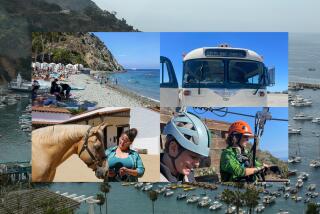ARMS RACE : Glendaleâs Berriz Endures Rigors of Paddleboarding
GLENDALE â One of the first lessons Armando Berriz learned about paddleboard racing was that he needed to wear a shirt.
âWhen I donât wear one, Iâll come home with blood trickling out of my nipples,â he said.
Such are the rigors of a sport in which men and women spend hours prone on sleek fiberglass boards, scratching their way across ocean waters. These seafarers are recognizable by their determined nature, their wide shoulders and muscled arms.
Today, dozens of them--including Berriz, a Glendale attorney--will compete in the inaugural Rock to Rock race from Catalina Island to Rancho Palos Verdes.
The 23-mile course is considered a middle-distance event. The winner should cross the finish line at Point Vicente Lighthouse Rock in under four hours.
By comparison, the Catalina Classic, which ranks among Southern Californiaâs best-known events, stretches 32 miles and can take more than nine hours to complete.
âThis will be a fast race,â said Joe Bark, a veteran competitor and organizer of the Rock to Rock. âYou get to cross the channel, which is exciting, but youâre laying off that last, hard 10 miles.â
Still, Berriz does not expect a leisurely outing.
The 29-year-old lawyer has been getting up at 3 a.m. to drive to Malibu for practice before going to work. Hitting the water before dawn, he paddles north toward Point Dume for an hour or more, then turns around and paddles back.
Berriz is a relative newcomer to this endeavor. An avid surfer who has ridden waves all around the world, he took up paddleboarding with a friend just a year ago.
He started by purchasing a second-hand board, an 18-footer dubbed the âHoly Mackerelâ because, legend has it, a previous owner raced the thing with a mackerel tied to the bow.
On mornings when the sea lay glassy and quiet, he encountered the joy of the sport.
âAbsolute peace,â he said.
After only a few months of training, Berriz entered the Catalina Classic.
âThere was wind and an unusual northwest swell that kept pushing paddlers south of where we needed to be,â he recalled. âWe crossed the channel but ended up pretty far south of the Palos Verdes lighthouse.â
Berriz struggled against the elements, still miles from the finish line. He realized that the prevailing current was pushing him backward. It was time to surrender, to climb aboard an escort boat.
âSeven hours had gone by and I was comatose,â he said. âI was cursing out there and swearing that Iâd never do this again.â
But he has returned for the same reason that he was initially drawn to the sport. Like others, he was attracted by its lore.
Paddleboarding has always been linked to surfing. The true watermen of Hawaii prided themselves on being able to swim and paddle long distances in addition to riding waves closer to shore.
This heritage stretches from Duke Kahanamoku to current big-wave rider Laird Hamilton.
âThere are legendary figures who have done this day-in and day-out,â Berriz said. âItâs inspiring.
Chief among the sportâs great figures is Tom Blake, a transplanted Californian who worked as a Santa Monica lifeguard in the early 1920s. Blake was interested in duplicating ancient Hawaiian boards he had seen in the Bernice Pauahi Bishop Museum in Honolulu, boards that were dismissed by modern surfers as too large and heavy.
Indeed, when Blake set about shaping a board from four-inch-thick redwood, it weighed an unmanageable 150 pounds, according to âThe History of Surfingâ by Nat Young. So he drilled hundreds of holes in the wood, shaving 50 pounds from the overall weight, then covered the top and bottom with a thin veneer.
The evolution of the paddleboard had begun.
Purists were initially skeptical, but Blake converted them by winning races, including the first mainland-to-Catalina event in 1932. In the years that followed, shapers made 60-pound boards with even thinner layers of redwood stretched over frames like those of airplane wings. Blake developed a fin to make the boards more stable.
These days, paddleboards are constructed of polystyrene and epoxy. They have flat decks and rounded hulls; the nose and tail are pointed to knife through waves. Unlimited class boards measure 18 feet or longer and weigh upward of 30 pounds. Stock class boards are 12 feet and 20 pounds.
Hamilton and a fellow Hawaiian, Buzzy Kerbox, paddled stock boards from France to England in 1990. After that, they paddled 43 miles from Corsica to Elba, off the Italian coast.
Technological advances have made the craft faster but have not eliminated the arduous nature of the sport. Racers still struggle against waves and currents, fighting wind chop and patches of seaweed that can make for painfully slow-going.
âIt was harder than I thought it would be,â Berriz recalled of his early experiences. âIt was back-breaking.â
The Rock to Rock, like other races of its kind, will start early, at 6 a.m., and finish by mid-morning, hopefully before troublesome winds have a chance to stir.
There will be 10 safety boats manned by paramedics and lifeguards along the course and each paddler must arrange for his own escort, someone to follow in a powerboat.
Berriz is hoping for a better result than the last time he crossed the channel. His early morning workouts have made him fit and he has repainted his board, adding the name of his wife, Catherine, to the tail.
âThe conditioning, the endurance,â he said. âThe old notion of the waterman is coming back.â



